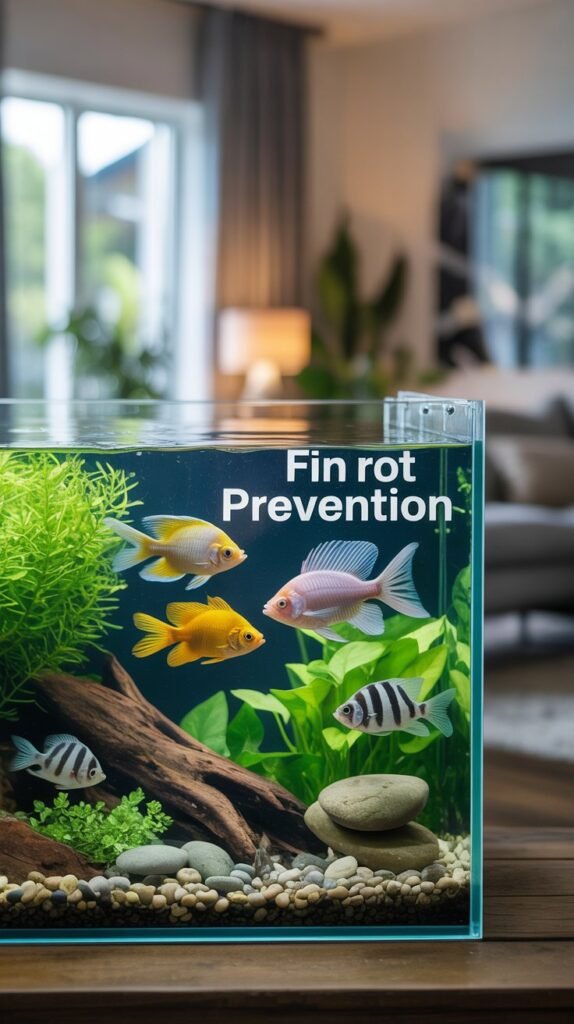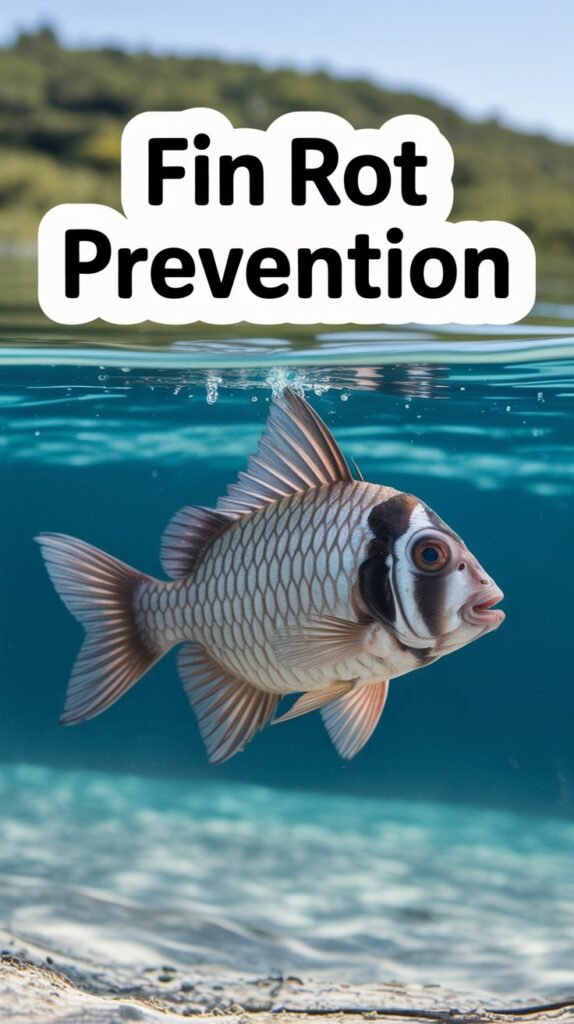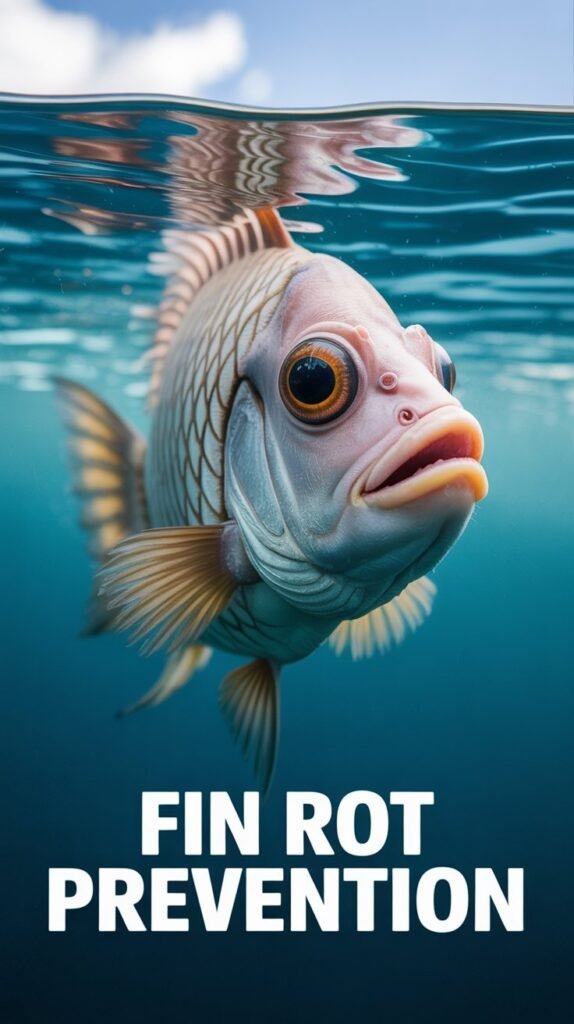Fin rot is one of the most common aquarium diseases, affecting both freshwater and saltwater fish. While it may start as a small tear or discoloration on the fins, it can quickly progress into severe tissue damage, infections, and even death if left untreated. The good news is that fin rot is almost always preventable with the right care and aquarium management.
This guide dives deep into fin rot prevention strategies, covering water quality, diet, tank setup, fish selection, and long-term maintenance practices. By following these tips, you can protect your fish from fin rot and ensure they thrive in a healthy, stress-free environment.
Understanding Fin Rot
Before diving into prevention, it’s important to understand what fin rot is and why it occurs.
Fin rot is typically caused by opportunistic bacteria (Aeromonas, Pseudomonas, Vibrio) or fungi that attack the fins when fish are stressed, injured, or living in poor water conditions. Unlike other diseases, fin rot doesn’t just “appear”—it develops because of underlying stressors in the aquarium.

Why Prevention Is Better Than Cure
- Treatment can be stressful for fish and may not always work in advanced cases.
- Fins take time to regrow, and some may never fully recover.
- Medication affects the entire aquarium, sometimes harming beneficial bacteria.
- Preventing fin rot keeps the whole tank healthier and reduces long-term costs.
Key Factors in Fin Rot Prevention
Preventing fin rot requires a holistic approach. You must maintain excellent water quality, reduce stress, provide a proper diet, and ensure tankmates are compatible. Let’s break down the main strategies:
1. Maintain Excellent Water Quality
Water quality is the single most important factor in preventing fin rot. Poor water conditions weaken fish immunity, making them vulnerable to bacterial and fungal infections.
Steps for Water Quality Management:
- Regular Water Changes
Perform 25–30% water changes weekly to dilute toxins. In heavily stocked tanks, increase frequency. - Gravel Vacuuming
Uneaten food and fish waste settle in the substrate, releasing harmful ammonia and nitrites. Regular vacuuming prevents buildup. - Water Testing
Use test kits to monitor ammonia, nitrite, nitrate, and pH. Ideal conditions:- Ammonia: 0 ppm
- Nitrite: 0 ppm
- Nitrate: under 20–40 ppm
- pH: stable, species-dependent
- Filtration System
Invest in a high-quality filter that provides mechanical, chemical, and biological filtration. Clean filter media carefully to preserve beneficial bacteria. - Avoid Sudden Changes
Keep temperature stable and avoid large pH fluctuations. Stress from sudden environmental changes weakens immunity.
2. Avoid Overcrowding
Overcrowded tanks lead to:
- Excessive waste → poor water quality
- Increased aggression → fin injuries
- More stress → lower immunity
Prevention Tips:
- Follow the one inch of fish per gallon rule (for small species).
- Research the adult size of fish before buying.
- Provide ample swimming space and hiding spots.
3. Select Compatible Tankmates
Fin nipping is a major cause of injuries that develop into fin rot. Species like tiger barbs, serpae tetras, or aggressive bettas can damage fins of peaceful fish.
How to Prevent Aggression:
- Research compatibility before introducing new fish.
- Keep schooling species in groups to reduce stress.
- Provide hiding places (plants, caves, driftwood) to minimize bullying.
4. Provide a Balanced Diet
A strong immune system is the best defense against fin rot. Fish fed a poor diet are more likely to develop infections.
Nutrition Tips:
- Variety Is Key – Offer flakes, pellets, frozen foods, and occasional live foods.
- Avoid Overfeeding – Excess food pollutes water. Feed only what fish consume in 2–3 minutes.
- Use Vitamin-Enriched Foods – Look for foods fortified with vitamin C, E, and garlic extract (natural immune booster).
- Supplement with Fresh Foods – Blanched spinach, peas, and spirulina help maintain health in herbivorous species.
5. Quarantine New Fish and Plants

New fish can introduce bacteria, parasites, or fungal spores into your aquarium.
Quarantine Practices:
- Place new fish in a separate tank for 2–4 weeks.
- Observe for signs of fin rot, ich, or other diseases.
- Treat proactively with mild salt baths if necessary.
- Rinse new plants before adding to the aquarium to avoid transferring pathogens.
6. Reduce Stress
Stress lowers immunity, making fish more vulnerable to fin rot.
Ways to Minimize Stress:
- Maintain stable water temperature.
- Avoid tapping on glass or sudden movements.
- Use proper lighting cycles (8–12 hours light, rest in darkness).
- Acclimate new fish slowly to prevent shock.
7. Monitor and Treat Minor Injuries Quickly
Small fin tears from netting, transport, or aggression can become infected. Inspect fish regularly and act fast.
Quick Actions:
- Move injured fish to a hospital tank.
- Add a small amount of aquarium salt (if species-safe).
- Keep water pristine to promote natural healing.
8. Use Preventive Additives
Some natural additives strengthen fish immunity and help prevent infections.
- Aquarium Salt (for freshwater, non-scaleless species)
- Indian Almond Leaves – Release tannins with antibacterial properties.
- Garlic Supplements – Enhance immunity and appetite.
- Probiotics in Fish Food – Support gut and immune health.
9. Maintain a Proper Cleaning Routine
Dirty tanks are breeding grounds for bacteria. Create a consistent cleaning schedule:
- Weekly partial water change
- Monthly filter maintenance
- Gravel vacuuming every 1–2 weeks
- Removing decaying plants and uneaten food
10. Observe Your Fish Daily
Prevention isn’t just about water tests—it’s also about knowing your fish. Daily observation helps you catch early signs of stress or disease.
Look for:
- Frayed or ragged fins
- White edges or discoloration
- Lethargy or hiding behavior
- Reduced appetite
Catching problems early often means a simple water change can prevent fin rot from developing.
Fin Rot Prevention by Fish Type

Some species are more prone to fin rot than others, especially those with long, delicate fins. Here are prevention tips for popular aquarium fish:
Bettas
- Avoid fin-nipping tankmates.
- Keep water warm (78–80°F).
- Provide gentle filtration to prevent fin damage.
Goldfish
- Produce lots of waste—ensure heavy filtration.
- Perform more frequent water changes.
- Avoid sharp decorations that can tear fins.
Guppies & Mollies
- Sensitive to poor water quality—test parameters often.
- Provide live plants to reduce stress.
- Feed a variety of protein- and plant-based foods.
Tetras & Barbs
- Keep in proper school sizes to reduce aggression.
- Avoid overcrowding.
- Provide plenty of swimming space.
Long-Term Fin Rot Prevention Checklist
Here’s a quick checklist to keep your aquarium healthy:
✅ Perform weekly partial water changes
✅ Use a reliable filtration system
✅ Test water parameters regularly
✅ Avoid overcrowding the tank
✅ Choose tankmates wisely
✅ Feed a balanced, varied diet
✅ Quarantine all new fish and plants
✅ Monitor fish daily for early symptoms
✅ Maintain a cleaning routine
✅ Reduce stress through stable conditions
FAQs on Fin Rot Prevention
1. What is the best way to prevent fin rot in bettas?
Keep the water clean, avoid strong currents, and house bettas alone or with non-aggressive tankmates.
2. Can fin rot be prevented without medications?
Yes. Good water quality, stress reduction, and proper diet are usually enough to prevent fin rot.
3. How often should I change water to prevent fin rot?
For most tanks, 25–30% weekly is recommended. Heavily stocked tanks may require more frequent changes.
4. Do plants help prevent fin rot?
Yes. Live plants improve water quality by absorbing nitrates, provide hiding spots, and reduce stress.
5. Is aquarium salt necessary for prevention?
Not always. Salt helps in some cases but should not be used long-term, especially with scaleless fish.
6. Can fin rot come back after treatment?
Yes, if the root cause (poor water quality, stress, aggression) isn’t resolved, fin rot can reoccur.
7. What’s the biggest mistake fish keepers make that causes fin rot?
Overfeeding and neglecting water changes are the most common mistakes leading to fin rot outbreaks.
Final Thoughts
Fin rot may be one of the most common fish diseases, but it is also one of the easiest to prevent. By maintaining excellent water quality, feeding a nutritious diet, avoiding overcrowding, and reducing stress, you can keep your fish safe from this painful condition.
Remember: a clean, stable, and stress-free aquarium is the best defense against fin rot. Prevention not only saves your fish from suffering but also creates a thriving, beautiful aquatic environment for years to come.

